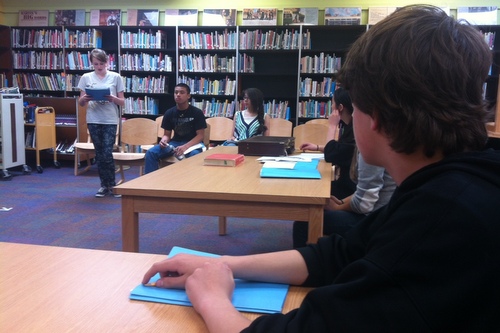
Blatchley students listen as the verdict is read in the People vs. Andrew Jackson. The eighth graders put the seventh president on trial while learning about the Indian Removal Act of 1840. (KCAW photo by Ed Ronco)
In 1830, President Andrew Jackson signed the Indian Removal Act into law. The measure allowed him to negotiate the movement of Native Americans from the southern states to west of the Mississippi River. And the policy laid the groundwork for the Trail of Tears, which included a forced march of Cherokees out of northern Georgia which took place after Jackson’s presidency.
Last week in Sitka, the former president went on trial before a jury of eighth-graders.
In this courtroom, the lawyers, the judge, the jury and most of the witnesses are all about 14 years old. We’re in the library at Blatchley Middle School. Court comes to order and eighth grade social studies teacher Roxann Gagner, playing the role of bailiff, swears in a witness.
The witness — President Andrew Jackson — is nervous. It’s his fourth time testifying that day. He’s already been shredded by two prosecutors and, as he sits down to testify again, he hopes he knows how to answer his own lawyer’s questions.
I know this because, well, I am playing Andrew Jackson.
“Do you believe that the Cherokee were obligated to follow the laws of Georgia?” says Colton Cummins, 14, one of the defense attorneys in the case. He paces back and forth as he asks questions in a Matlockian southern accent.
Let me tell you: It’s not easy to answer questions as Andrew Jackson might. Facing the prosecutors is no picnic either. They go for the jugular and ask me President Jackson exactly what his problem is with Native Americans.
“What makes them different from any other man? Or woman? Or child?” one of them asks.
“Um. I don’t know,” I say after a long pause, trying to look presidential.
“No further questions,” she counters, immediately.
Kasi Pittser was one of the many prosecutors to put me in the hot seat on the stand. She says she wants to be an attorney when she grows up.
“Because I’ve always been really good at arguing with people. I was really excited to play this role. I was ready to kick some butt,” she says. “It felt really good. I was really proud of myself. I’m going to go call my mom right now.”
Gagner, the students’ teacher, says the students have to research their own roles and are not following a script. Teaching this part of American history as a trial, she says, requires the students to not just memorize the information, but to apply it — to actually know what they’re talking about.
“The lawyers are creating their own questions,” Gagner says. “The witnesses are looking at the biographies of the people they’re playing and pulling out the pertinent information that will determine the outcome of the trial.”
And the students are learning a thing or two about the American legal system, in addition to the Indian Removal Act. They’re expected to follow the procedures of a trial, and to exercise courtroom decorum.
Of course, one judge did have to try his entrance again after high-fiving a defense attorney on the way to the bench, and another lawyer was excused from court after a particularly robust belch. But all of them presented passionate, logical, well-researched arguments on both sides.
“And it’s so appropriate at this age level, because they realize things aren’t just black and white,” Gagner says.
And that leads to a serious point: During the particular incident these students are studying, some 15,000 Cherokee were forced to leave Georgia. More than 4,000 died along the way. Saying it was a brutal experience and that conditions were difficult is, at best, an understatement. Gagner says her students are having fun with the trial, but that they definitely understand the gravity of what happened.
“With all of the situations that we’ve looked at with U.S. history, or any people’s histories, there are always those really difficult, horrendous situations of how people treat each other,” Gagner says. “The students also, earlier in the year, in their language arts class, studied the Holocaust. So, they did have background information on human atrocities that they did apply to this court case as well.”
In all, five classes put me on trial as Andrew Jackson. Three of the juries acquitted Jackson, arguing that he shouldn’t be blamed for events that happened during Martin Van Buren’s term. Two classes convicted him.
Huge cheers erupted in most classes from the victorious side, as other students gasped in disbelief. Who says history is boring?






























